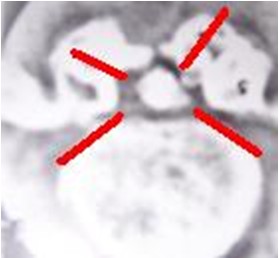
Failed Back Surgery Syndrome (FBSS)
Case Sharing
After 45-year-old Miss Li underwent lumbar L5/S1 laminectomy in February 2009, although her foot numbness has been greatly improved , the condition of low back pain has not changed. She also feels that her lower back muscle strength is getting weaker after the operation. She felt fatigue, stiffness, and soreness in her lower back. After 15 minutes of sitting, her lower back also felt pain, which caused her to either stand up and squat down immediately to relieve the back pain.
In June of the same year, she again asked the doctor to perform another operation on her, but the doctor believed that another operation might not help to improve her pain. They suggested doing more exercises to strengthen the back muscles to improve back pain. After that, Ms. Li began swimming, running and cycling, hoping to help improve the condition of low back pain. But in December (after half a year of exercise), the back pain became more and more serious, and the numbness of the feet began again. This situation is called “fail back syndrome after spinal surgery".
Case Analysis
Fail Back Surgical Syndrome (FBSS) has many reasons, though extensive, it can be roughly analyzed as follows:
- Inappropriate diagnosisSurgery skills
Spinal nerve instability after surgery
Poor healing after spinal fusion surgery
Complications caused by the operation itself
Research report on failure syndrome after spinal surgery
FBSS does not refer to the failure of the operation itself, but includes the patient’s continued low back pain, sciatica, and even functional disorders after the operation.Many research reports have pointed out that one of the reasons for postoperative failure is the appearance of some scar tissue (epidural fibrosis) after spinal surgery. The formation of these scar tissues is caused by fibrous changes in the periosteum and paraspinal muscles that have been scarred after surgery. Scar tissue usually attaches to the nerve roots of the spine, so it forms a compression effect, causing the patient’s pain to reappear. Recently, other studies have shown that the back pain after the operation is not necessarily caused by the scar tissue directly compressing the nerve, but after the operation The lesions caused by the nerve roots have caused some extremely painful new pain nerves to grow in the scar. These pain nerves may be the cause of postoperative back pain and sciatica.

Red area contains the epidural fibrosis
Surgical treatment vs Conservative treatment
1) Surgical treatment :
The main purpose of surgical treatment is to relieve the symptoms of nerve root compression and avoid more serious damage to the compressed nerve root. The serious symptoms of the patient are as follows, the surgery should be considered.
1. Unbearable or no medication can relieve low back pain and foot pain
2. Severe impact on daily life or incontinence, (called cauda equina syndrome)
3. Conservative treatment for more than 6-8 weeks cannot relieve pain or paralysis.
4. During conservative treatment, nerve defects are still found.
Satisfaction report on surgical treatment:
Surgical treatment data show that within 6 months after undergoing the operation, the success rate of the operation is about 75-90%. However, after a long period of time, it is found that more than 40% of patients are not satisfied with the results of the operation, and even more than 15% of patients require the second operation to solve the first operation.
2) Conservative Treatment
Conservative treatment is the treatment of non-surgical methods, so that the patient can relieve the pain and restore its original functional activities. In a number of conservative treatments, Cox® decompression therapy can help patients with disc herniation or postoperative back pain to improve their symptoms. Generally, patients can receive Cox® decompression therapy 6-12 weeks after surgery. If the patient has undergone spinal fusion surgery, treatment can be started 12-16 weeks after surgery.

 Book an Appointment
Book an Appointment


